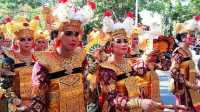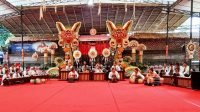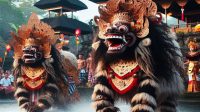IMAGINE yourself standing at the spiritual gateway of Bali, where the majestic Mount Agung serves as a sacred backdrop. Welcome to Besakih Temple, the ‘Mother’ of all temples on the Island of the Gods.
Besakih Temple is located in Besakih Village, Rendang Subdistrict, Karangasem District, precisely on the southwest slope of Mount Agung, the highest mountain in Bali.
The journey to Besakih Temple from Denpasar City can be taken via Jalan Bypass Ida Bagus Mantra, turn left towards Takmung (Banjarangkan) then Semarapura Town or via Denpasar City–Gianyar Town towards Semarapura and is about 25 km north of Semarapura Town passing the Bukit Jambul, one of the tourist objects of Karangasem District.
Well, related to the name of Besakih itself, it is said to be taken from Sanskrit, namely wasuki or in Old Javanese basuki which means safe. There are also those who say that the name of Besakih Temple is taken from the mythology of the Basuki Dragon who is the balancer of Mount Mandara.
Nestled at the foot of Mount Agung, Besakih Temple has a number of temple complexes. One of them is the Penataran Agung becoming the center of the Besakih Temple. According to Raja Purana Besakih palm-leaf manuscript, the Penataran Agung Temple is the gathering place of the gods.
In this temple complex, there are the Padma Tiga shrines which is the most important temple of all the temples in Bali. These shrines are used to worship Ida Sang Hyang Widhi, the Almighty God, in His manifestation as Sang Hyang Tri Purusa who are the great souls in this universe.
As the name suggests, the Padma Tiga consists of three padma shrines. Firstly, on the far right there is a padma shrine with black cloth, which is a symbol of Parama Shiva who is outside the universe. In this case, God is depicted in a state of Nirguna Brahman or without attributes, meaning that humans cannot possibly represents the attributes of the Almighty God.
Secondly, Padma Tiga in the middle is fitted with white and yellow cloth which symbolizes Sada Shiva, namely God in the state of Saguna Brahman which means that God has shown the characteristics of the niskala or transcendental to create a holy and prosperous life. In this concept, white color symbolizes purity and yellow symbolizes prosperity.
Thirdly, Padma Tiga located on the far left is fitted with red cloth, symbolizing Shiva which depicts the existence of God who is already in a state of krida as Tri Kona. In this case, God as Shiva manifests into Tri Murti consisting of Brahma, Vishnu and Shiva.
Hindus usually perform prayers at this Penataran Agung Besakih after praying at their respective clan temple. (*)










